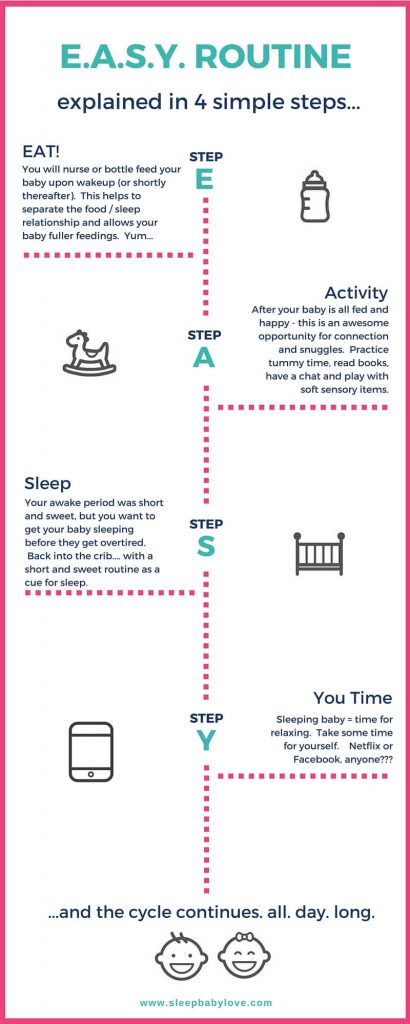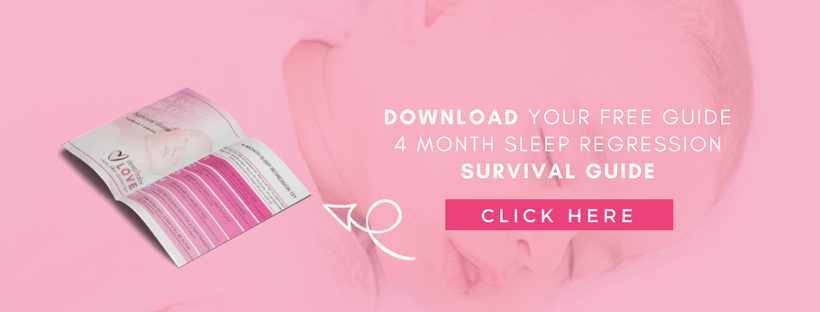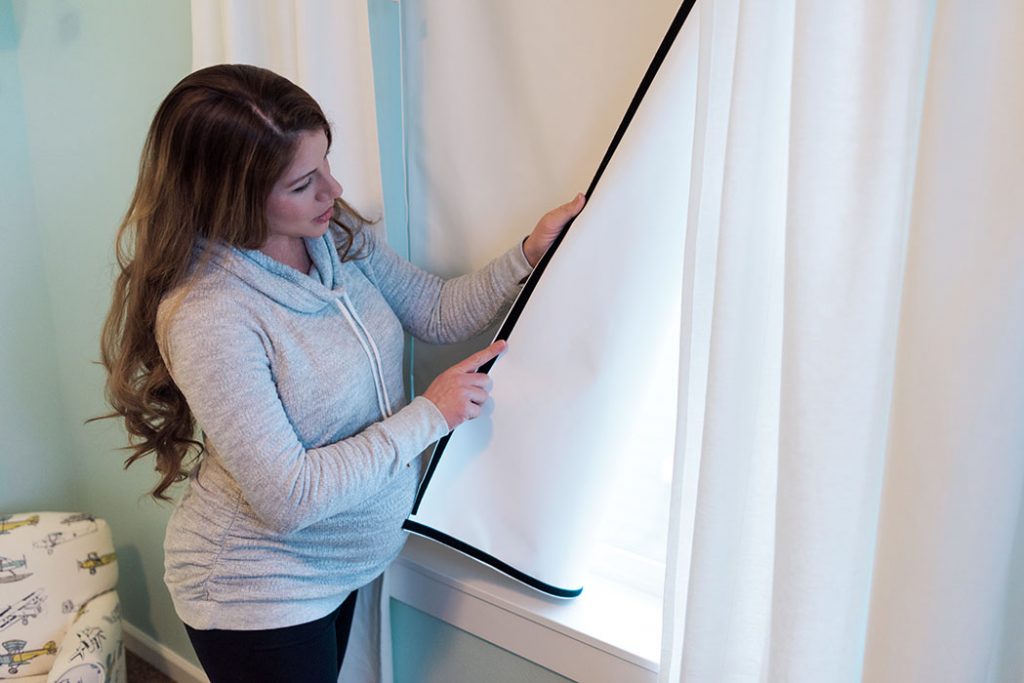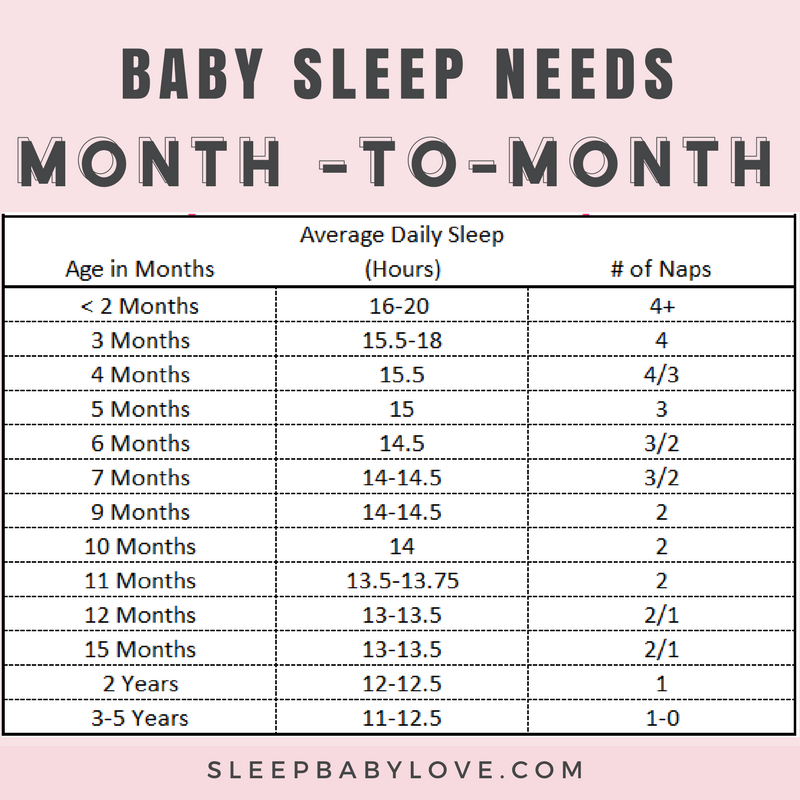The 4 Month Sleep Regression SUCKS!
It must be a baby sleep regression. It is probably keeping you up at night. You may be googling and wondering what happened – “4 month sleep regression” “baby isn’t sleeping anymore”, any and every keyword combination to figure out what it is…
You were the lucky one. The one who could tote around your newborn baby with ease. Your baby didn’t have that fussy spell that your friends talked about. Sure you had a night feed or two, but that’s OK. It’s a NEWBORN baby.
Now you don’t feel so lucky…
Your baby is getting up a lot. Every 2 hours, sometimes every hour. And, what’s up, with the fussiness and crankiness and fighting his naps!?
Oh No, it must be a sleep regression?! The 4 Month Sleep Regression SUCKS!
What is a sleep regression?
A sleep regression is a result of changes that are occurring in your baby. Your baby is developing and so many biological changes occur in their little brain – such as making connections with the world… and you… Those social smiles mean that your baby is connecting…connecting with you and wanting to be with you. Not to mention, not wanting to sleep so well.
THE CAUSES OF BABY CHANGES AT 4 Months
Sleep Becomes More Adult-Like: As a newborn, your baby goes into a deep sleep almost immediately. Now, your baby goes through various stages before hitting that deep sleep mark (drowsy, light sleep, and finally a deep sleep).
You may be familiar with this if you are rocking or feeding your baby to sleep and it now takes FOREVER (about 20 minutes) to be able to put your baby down finally. If you do it too early you get an immediate wake-up and you have to start ALL OVER!
Cognitive Abilities Are Changing: According to the American Academy of Pediatrics, your baby will start to understand the ability of cause and effect. She’ll understand that she can rattle her crib by moving her feet. She was making noises from keys if she shakes them. She’s starting to understand the world around her and wants to explore.
Transferring from between sleep cycles isn’t as easy: Breaking news, this whole baby soothing-to-sleep thing is actually a skill and it’s not always an easy one to master.
Your baby now has to practice going in and out of sleep cycles, which typically end around the 35-45 minute mark.
Until the soothing skill is mastered, you may see some short naps which end after one sleep cycle. And if your baby is overtired, that nap can be even shorter (less than 30 minutes). Bummer.
Short Naps Aren’t Going to Cut It: Your job with a newborn is to keep your baby well-rested and do what you need to do to get your baby sleeping.
A newborn baby’s sleep patterns are very erratic resulting in a combination of short and long naps.
Now that your baby is right around the 4-month mark, you may start to see that short nap after short nap may be a sure-fire recipe to create a sleep debt resulting in an overtired baby.
4 MONTH BABY FIGHTS SLEEP
Your Baby is Aware of You: You know those smiles that melt your heart? They mean something! Your child is aware. She can look for you and sense your presence. Your baby wants to be with you and can sense when you aren’t there.
If you were a baby wouldn’t you want to be on your mom’s boob or in your dad’s arm? That’s all they know, you can’t blame them.
Let’s do the 4-3: As day sleep consolidates, the transition occurs from 4 naps to 3, right around the (3 – 5-month mark).
Like other nap transitions, you may see changes in your baby’s wake up time or bedtime.
Many parents forget that an earlier bedtime is the best way to get through the transition. So it’s possible that too late of a bedtime doesn’t work for your baby.
Is the 4 Month Sleep Regression A Myth?
You keep hearing about this huge regression and it’s making you wonder if you will ever have a baby that sleeps again. While I think there are many myths that parents buy into to get a little bit extra of shut-eye. A sleep regression isn’t so much a myth but rather due to changes and development that makes you look a little closer at sleep to get things on track.
The 4 Month sleep regression has a good ring to it so it’s easy to finger point at bad sleep habits.
I’m telling you now, that if you are ready to focus on sleep habits – you could have some wins by focusing on sleep environment and nap timing. Still, eventually, your baby needs to have independent sleep skills to get all variables in place.
When Does The 4 Month Sleep Regression End?
So now that you’re experiencing the 4-month sleep regression, and things go blissfully back to normal in a few days or a week, consider yourself lucky. You are out of the proverbial sleep woods.
Your baby can get back to being a decent sleeper and all is good in the world. But, what if you aren’t the lucky one?
What if the regression is longer?
After 2 weeks if you are still battling on getting your baby to sleep and short naps and multiple night wakings are not your friends.
Well then… Maybe the sleep regression that you are experiencing is a friendly reminder to focus on healthy sleep habits?!
4 Month Sleep Regression Tip and Solutions!
- Focus on an environment conducive to sleep: Now is a great time to get your baby sleeping in his crib. If for the last 4 months the crib has been nothing more than an oh-so-beautiful, expensive decoration now is the time to start using it. I know you’ll miss the car naps, but sleeping on the go is not working anymore. Hunker down and get your baby sleeping in the crib. The crib will provide the safest sleep environment and provide your baby a cozy place to call home.
- For a slow and steady approach to get your baby sleeping in the crib, work on one quality nap a day in their crib (typically the first nap of the day is easiest) and bring the remaining naps to the crib over time.
- Make your baby’s room super dark – I’m talking cave dark. The darker the better, especially if your baby is taking short naps. I am in love with this blackout shade covering to keep the dark away (while offering some nice heating and cooling qualities – win, win)! DIY remedies such as taping poster board or tin foil to the windows will work as well, albeit not as pretty. If you would like to shell out the
- cash, a combination of blackout shades and drapes help the light stay out (Click the link below to learn more about Blackout EZ shades)
- Don’t forget to plug in your white noise machine to offer a comforting “womb-like” background noise.
- Don’t rush to ditch the swaddle: Continue with the swaddle if your baby is not yet rolling and still shows that he has a strong moro reflex (twitchiness of his arm that typically wakes him up). When you are ready to ditch the swaddle you can transition into a sleep sack. I’m also a huge fan of the Baby Merlin’s Magic Sleep Suit if your baby still needs that cozy (look like an astronaut) feel.
- Focus on an earlier bedtime: As sleep consolidates (especially as you go through the 4 to 3 nap transition), your baby’s bedtime will naturally move earlier, and is extremely important to keep your baby well-rested. On average a baby’s bedtime is between 6 and 8 pm but don’t be scared to move your baby’s bedtime earlier on days when naps are less than stellar or that the 3rd nap is missed. Most babies go to bed between 6 and 8 pm.
- Keep those wake periods short! Still, at 4 months your baby can’t handle too much awake time before becoming overtired. Focus on making sure that your baby is not up for longer than 2 hours but the right number for your baby may even between 1-1.75 hours.
- E.A.S.Y routine: It’s always a great idea to move the feeding away from sleeping to help focus on independent sleep skills. In Secrets of a Baby Whisperer, Tracy Hogg explains that EASY means EAT, ACTIVITY, SLEEP, and YOU time. Pretty self-explanatory, but the eating happens after the nap vs. right before it. This guidance helps disassociate sleep and eating, which is a helpful skill when it comes to overnight sleep. (Also, the you time of the EASY routine is heavenly).

- Night Feeds, No Problem!? Sleeping through the night starts to happen when your baby learns the golden rule of amazing sleep, focusing on 1) soothing skills 2) age-appropriate nap times, and 3) bedtimes at the right time. Until then, it’s not uncommon for your baby to continue to need a feed or two during the middle of the night. If your baby gets a stretch of 5 hours and another between 3 to 4 hours, you are a rockstar – if your baby is getting up every two hours in the middle of the night, there most likely is more going on.
- Night Diapers: Some babies don’t like sitting in a wet diaper, but the constant night diaper changes are actually doing more harm than good for many babies. Huggies and Pampers create diapers starting at size 3 (which starts at 16 lbs.) HERE ARE PLENTY OF NIGHT DIAPERS TO CHECK OUT (click the link). I’m also a huge fan of the Target brand for diapers. It’s worth the try!
- Put Down Drowsy But Awake: As stated above, this baby sleep thing isn’t always so easy, but the foundation to having your baby learn amazing sleep habits is focusing on falling asleep independently by putting your baby down drowsy but awake. Since self-soothing is a learned skill for some babies, you have to allow your baby the opportunity to fall asleep independently by choosing a sleep training method that works best for you and your family philosophy (—>this epic sleep training article can give you way more info). Having a support system (like me) can be really helpful, especially since there is so much contradicting information on the internet. YOU have to be ready to make a change when you are helping your baby learn healthy sleep skills. If you aren’t ready, you’re not ready, and you can both wait until you are.
3 Sleep Tips To Combat The 4 Month Sleep Regression
Let’s make things actionable so you can set your baby’s sleep on the right path:
Tip 1: Set Your Baby Up For Success: Focus on keeping your baby well-rested (easier said than done!), but sleep is so much harder when your baby has to try to fall asleep in an overtired state. Try keeping your baby up for a maximum of 1.5 -2 hours between naps. There is a magical time when your baby won’t fight sleep – you have to find what it is.
Tip 2: Focus On The Numbers: Your 4-Month-Old is capable of sleeping on average 15.5 hours of sleep (including both naps and night sleep). How much total sleep is your baby getting? Are you close? If not, try another nap throughout the day or bring bedtime earlier.
Tip 3: Are there any independent skills? Your baby will need to fall asleep and stay asleep by learning the skills to do so. First, you need to assess what’s standing in the way of your baby falling asleep. So let me ask, what’s standing in the way of your baby falling asleep??? The things standing in the way are called sleep associations and include:
- bouncing
- rocking
- feeding
So instead of feeding your baby to sleep – try rocking your baby to sleep. If you are rocking your baby to sleep, try standing over the crib and stroke your baby’s face to fall asleep. You see, once you’re able to lessen a sleep association to fall asleep – independent skills will emerge!
Tip 4: Practice, Practice, Practice: If you feel overwhelmed with all of the tips in this article. STOP. Take a deep breath. Rome wasn’t built in a day, so don’t worry if your child’s sleep isn’t perfect today. When I sleep trained my daughter at 4-months, I knew it was time. She was miserable, and so were we. We were ready. I knew my daughter needed to learn independent skills, and I would give her the skills to do so. If you’re not ready – that’s OK too. Just keep practicing. Could you not rush to grab her at every peep? Things will improve if you keep practicing.
Will You Survive The 4 Month Sleep Regression?
It’s real, and the 4-month sleep regression may be the reason that your baby is not sleeping well. But, remember, the regression is a friendly reminder to instill healthy sleep habits for your little one.
Now is a great time to start focusing on teaching your baby self-soothing skills – since that’s the important skill to make sure that your baby becomes a great sleeper. And, once you get over this little hurdle successfully, there are many sleep bumps in the road to get ready for.
Did you know there is another sleep regression around 9, 11, and 18 months? So even when you get past this sleep regression, you have other things to forward to (Hey there, 8-10 Month Sleep Regression!). And to think, we didn’t even talk about the havoc caused by teething!
Tell us your experience. Did your baby have a 4-month sleep regression? Did it go away on its own? Did you have to make some changes to make your baby become a rock star sleeper?
YOUR TURN: DOWNLOAD your free 4 months sleep regression survival guide below or reach out to me for a 1:1 consultation (I can help!)




